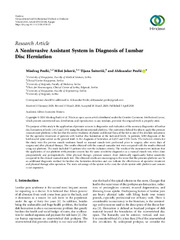Приказ основних података о документу
A Noninvasive Assistant System in Diagnosis of Lumbar Disc Herniation
| dc.creator | Peulić, Miodrag | |
| dc.creator | Joković, Miloš | |
| dc.creator | Sustersić, Tijana | |
| dc.creator | Peulić, Aleksandar | |
| dc.date.accessioned | 2021-09-24T15:45:36Z | |
| dc.date.available | 2021-09-24T15:45:36Z | |
| dc.date.issued | 2020 | |
| dc.identifier.issn | 1748-670X | |
| dc.identifier.uri | https://gery.gef.bg.ac.rs/handle/123456789/1052 | |
| dc.description.abstract | The purpose of this study is the application of pressure sensors in diagnostics and evaluation of the accuracy diagnostics of lumbar disc herniation at levels L4/L5 and L5/S1 using the aforementioned platform. The motivation behind the idea to apply the pressure measurement platform is the fact that the motor weakness of plantar and dorsal flexia of the feet is one of the absolute indications for the operative treatment of patients with lumbar disc herniation at the indicated levels. In patients, MRI diagnosis of the lumbosacral spine served as the ground truth in the diagnosis of herniation at L4/L5 and L5/S1 levels. The inclusive criteria for the study were the proven muscle weakness based on manual muscle tests performed prior to surgery, after seven days of surgery and after physical therapy. The results obtained with the manual muscular test were compared with the results obtained using our platform. The study included 33 patients who met the inclusion criteria. The results of the measurements indicate that the application of our platform with pressure sensors has the same sensitivity diagnostics as a manual muscle test, when done preoperatively and postoperatively. After physical therapy, pressure sensors show statistically significantly better sensitivity compared to the clinical manual muscle test. The obtained results are encouraging in the sense that the pressure platform can be an additional diagnostic method for lumbar disc herniation detection and can indicate the effectiveness of operative treatment and physical therapy after operation. The main advantage of the system is the cost; the whole system with platform and sensors is not expensive. | en |
| dc.publisher | Hindawi Ltd, London | |
| dc.relation | Clinical Center of Serbia, Clinic for Neurosurgery, Belgrade | |
| dc.rights | openAccess | |
| dc.rights.uri | https://creativecommons.org/licenses/by/4.0/ | |
| dc.source | Computational and Mathematical Methods In Medicine | |
| dc.title | A Noninvasive Assistant System in Diagnosis of Lumbar Disc Herniation | en |
| dc.type | article | |
| dc.rights.license | BY | |
| dcterms.abstract | Пеулић, Миодраг; Сустерсић, Тијана; Пеулић, Aлександар; Јоковић, Милош; | |
| dc.citation.volume | 2020 | |
| dc.citation.other | 2020: - | |
| dc.citation.rank | M22 | |
| dc.identifier.wos | 000526966000002 | |
| dc.identifier.doi | 10.1155/2020/6320126 | |
| dc.identifier.pmid | 32328153 | |
| dc.identifier.scopus | 2-s2.0-85083795748 | |
| dc.identifier.fulltext | https://gery.gef.bg.ac.rs/bitstream/id/48/1050.pdf | |
| dc.identifier.rcub | https://hdl.handle.net/21.15107/rcub_gery_1052 | |
| dc.type.version | publishedVersion |


